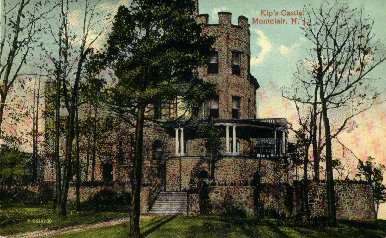|
- Allen B. Du Mont, Television Pioneer
The program traces Allen B. Du Mont's career, beginning with the development of a durable cathode ray tube in the garage of his Cedar Grove home. Du Mont later founded television station WABD in New York City, which soon became the flagship station for the Du Mont Television Network.
- Along the North Jersey Rapid Transit
The North Jersey Rapid Transit Company existed from 1910 to 1928. The line served East Paterson, Fair Lawn, Glen Rock, Ridgewood, Ho-Ho-Kus, Waldwick, Allendale, Ramsey, Mahwah and Suffern. Take a ride on this trolley a century ago when Bergen County was relatively undeveloped and compare it with the route as it appears today.
- Castles of New Jersey
Although not as numerous or grand as their European counterparts, a surprisingly large number of castles were built in New Jersey a century or more ago. This program will take you on a tour of well-known castles such as Lambert and Kip's castles as well as lesser known ones throughout the state. Many of them still exist, some have been disguised over the years, and others have vanished.
- Deserted Villages of New Jersey
There are several communities in New Jersey that have gone from being vibrant
in centuries past to essentially deserted today. Natural disasters, newer modes of
transportation, faulty government planning and insufficient business acumen
were the primary causes. The program focuses on the villages both as they
appeared in their prime and as they are today with many of the scenes presented
in a "Then and Now" format.
- Dining with History
The program focuses on many restaurants, mostly in New Jersey but several
in neighboring states, that began life as long ago as the 1700s. In
every case the building itself is an important part of New Jersey's
heritage whether it originally was a stagecoach stop, railroad station,
school, castle, private residence or other historic structure. The
program includes not only the origins of many of New Jersey's notable
dining establishments but also views of the restaurant as it appears
today. Additionally, nearby attractions of interest are also highlighted.
- Historical Highlights of New Jersey's Counties
The program focusses on historical highlights of
New Jersey's 21 counties. Sites and events include: deserted villages, a castle, the country's oldest
seaside hotel, canals, railroads, America's first coast-to-coast highway and "the trial of the century."
- The Morris Canal Yesterday and Today
The Morris Canal, the first bulk transportation system in New Jersey,
was drained and abandoned in 1924. This program follows the route of the
canal from the Delaware River at Phillipsburg to the canal's basin on
the Hudson River at Jersey City. Contemporary scenes were photographed
while walking most of the abandoned canal's 102 miles.
- New Jersey's Mills: Whatever Happened to Them?
More than a thousand water-powered lumber, grist, cotton, and woolen mills provided food, shelter, and clothing in New Jersey in the nineteenth century. Over the decades, some of those mills were converted to other uses; may fell into ruin; and others simply vanished. Surprisingly, a few still function today. This program examines the current state of many of the mills built in centuries past.
- The Passaic River: 81 Miles of History
This program follows the Passaic River thru seven counties from its source in Mendham to its end at Newark Bay with an emphasis on historic activities and structures along the river in past centuries. The focus is on topics such as: early mills, Glacial Lake Passaic, the first successful test of a submarine, extant Native American art and constructions, the country's first industrial city and the heroic exploits of the "great descender" Sam Patch.
- Railroads to Caldwell
The program examines the remains of the Caldwell Railroad which in 1872 began construction of a railroad between Montclair and Caldwell. Difficulty in boring a tunnel through First Mountain and a national financial crisis soon halted construction and work was never resumed. Its successor, the Caldwell Railway, was completed to Caldwell in 1891 and avoided First Mountain by going through Cedar Grove and Verona. The line, which later became the Caldwell Branch of the Erie Railroad, is examined in detail through 1979 when the rails were removed.
- Remember When?
The program focusses on 20-plus historical events introduced by relevant
popular songs. Events are memorable moments primarily in the areas of
entertainment, sports, transportation, politics and business. Years covered
range from the late 1930s through the end of that century. It is anticipated
that audience participation will be an integral part of the program.

Kip's Castle, Montclair/Verona
|







